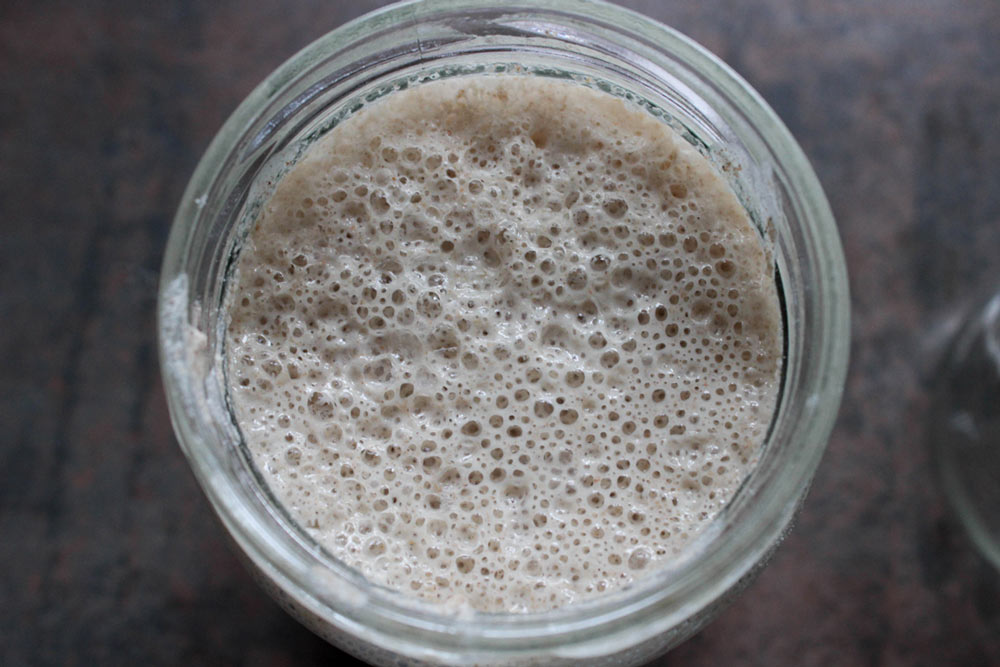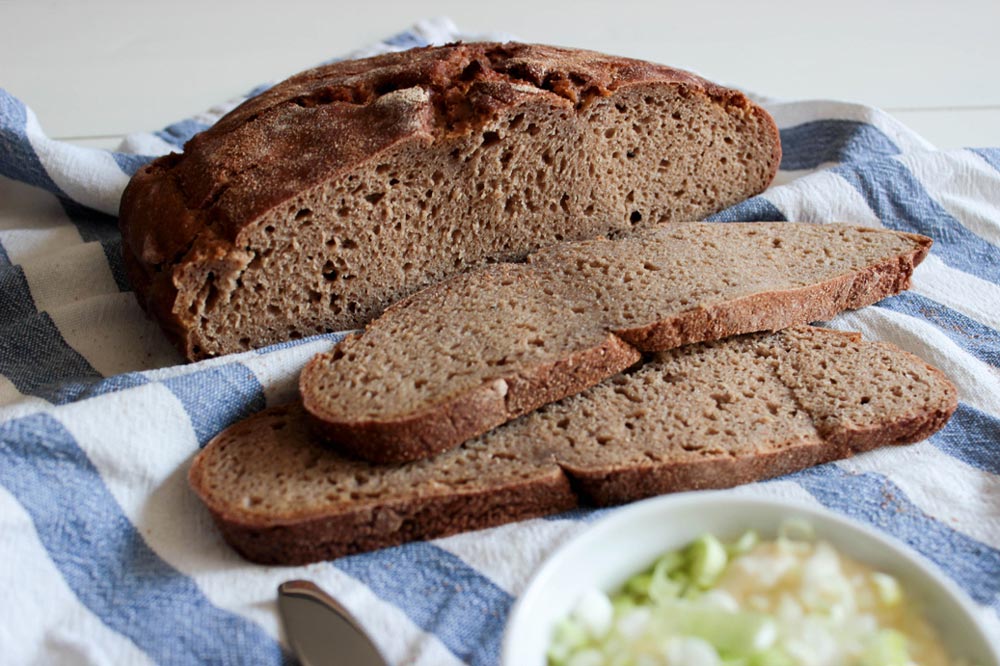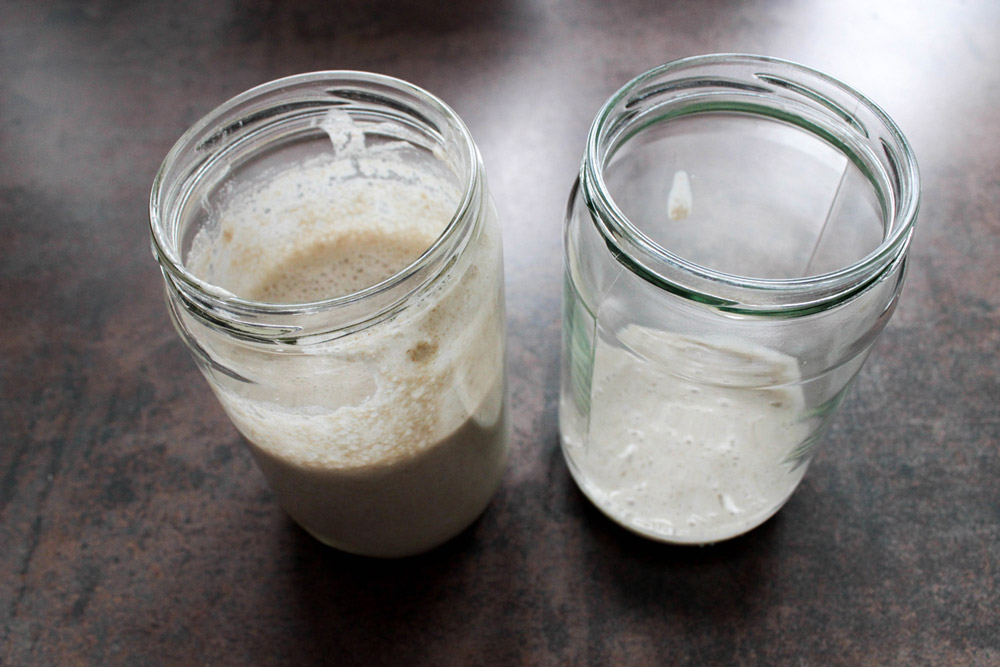Sourdough story: The story of Žofia

Everyone who likes to cook or bake, will (sooner or later) try to cook homemade bread. That was my case, too. I remember the enthusiasm we had, when we tasted our first home-made bread. My first bread I prepared at home was the easiest one; made from all-purpose flour and yeast. Gradually, I have started to experiment with ingredients and different types of flour until I discovered a new bread universe. Sourdough bread.
Thanks to the instructions and great advices from Viktor’s blog, I decided to make my own sourdough starter. Žofia, the sourdough mother, was created in April 2015. It survived even the difficult times and long-lasting separation. But at the end of 2016 it suddenly died. Since then I tried to recreate her successors Sofia (who didn’t survive her 10th day) and Mafia, who make us happy until nowadays.
Why is the sourdough bread so great? Thanks to the long and slow fermentation it is easier for us to digest sourdough bread than classical bread made with baker’s yeast. Moreover, the sourdough bread contains natural lactobacilli and yeasts which are beneficial for our digestive system. Slow fermentation helps to reduce the amount of phytic acid that binds to important minerals and prevents their absorption into the body.
Recipe for whole-rye sourdough bread.
How to raise your own sourdough starter
This is the theory that I was stick to during raising my first sourdough starter:
1st day – in a medium glass jar (app. 0.7 l) mix together 150–200 ml of lukewarm water with 100 g of bio rye flour (I use bio flour due to better quality of the flour), cover with cheesecloth and set aside.
2nd – 9th day – Add 50 g of rye flour and 50 ml of water every day.
10th day – You can make your first sourdough bread.
If you are going to use the sourdough to make a bread, take a 2 tbsp of the sourdough and put it in a clean jar. Cover the jar, put it in the fridge and save it for later. Don’t forget to feed the sourdough in the fridge at least once a week with 50 ml of water and 50 g of rye flour.
Use the remaining sourdough for baking bread.

Sourdough reality check – how Žofia, Sofia and Mafia were born
Here are my daily records about Žofia and how was she doing during her first days.
1st day – I mixed 200 ml of water with 100 g of whole-rye flour in a medium glass jar (0.7 l), we named the sourdough – Žofia (as it is mother dough it should have female name). We hoped that it will be alive in a few days. I covered the jar with clean kitchen towel and set to a warm place.
2nd day – Nothing special happened to sourdough until evening. It doubled its size and the magic happened. We were so excited that we uncovered it, but the sourdough suddenly deflated. I added 50 ml of lukewarm water, mixed it well and then added 50 g of whole-rye flour. I mixed it well again, covered it with clean kitchen cloth and wrap the jar in the towel.
3rd day – Surprise, surprise! Žofia felt so good in the towel, that she doubled its size, which meant that it leaked out of the jar. The towel was completely dirty, so I “enjoyed” the cleaning process. I put 3 tbsp of sourdough to new clean glass jar. In the evening I added 50 ml of water and 50 g of whole-rye flour, mixed well and cover with clean kitchen towel.
4th day – I fed the sourdough with 50 ml of water and 50 g of rye flour.
5th day – I forgot to feed the sourdough.
6th day – In the morning, I realized that I forgot to feed Žofia a day before, so I immediately add 50 ml of water and 50 g of rye flour. I was curious whether the sourdough will survive. I felt a bit of alcohol aroma, which wasn’t a good sign, but it disappeared in the evening. I add another 50 ml of water and 50 g of rye flour in the evening, mixed it well and put 3 tbsp of sourdough to new clean glass jar. I covered the jars with clean kitchen cloth and wrap them into towel.
I didn’t take notes the other days, but everything was smooth. No special situation or activity occurred and Žofia was stronger from day to day. I baked the first sourdough bread on the 8th day.
Unfortunately I didn’t make any photos of this first sourdough attempt. Maybe, it’s better that I didn’t do it. I used wheat flour (yes, you can use rye sourdough and make wheat bread). The look wasn’t very appealing, but my guest liked it. Maybe they saw the excitement in my eyes, so they didn’t want to ruin it.
Since then I tried to bake different types of sourdough bread – wheat-rye, whole-rye, wholegrain, with seeds, spices and herbs.
I store it in a glass jar (0.7 l) in the fridge max. 7 days without any attention.
As I already mentioned, Žofia made us happy for almost 2 years.
Žofia is gone, long live Sofia or Mafia
Based on the previous experiences, I mixed 200 ml of bottled water for babies and 100 g of wholegrain flour. The next day, several hours after feeding, we noticed the sourdough coming alive. We named it Sofia.
On the second day, I recommend to put the glass jar with sourdough in the bowl. It will probably leak out of the jar after feeding. Or you can use a larger jar. Until the 6th day, Sofia was doing well, but later on a kind of dry “skin” was formed on its surface, which was forming until its last day. I didn’t have a chance to bake any bread with this sourdough. Few days later I decided to make a new sourdough – Mafia.
The Mafia started to run smoothly until the 8th day, then the mysterious “skin” was created on its surface. This time I carefully removed the skin and put 2 tbsp of sourdough to clean glass jar. The skin was formed again, but I removed it once again and put the sourdough to clean glass jar and fed it with 50 g of water and 50 g rye of flour.
Removing the skin and putting it to a clean jars helped and on the 12th day of Mafia’s life, I preheated the oven, put in an empty baking pan (to preheat it) and bake a sourdough bread. I baked it for 15 minutes at 250°C, 40 – 50 minutes at 200°C. The bread rested for few hours after baking and we enjoyed its delicious taste in the evening.
Based on the previous experiences, I immediately dried out about 2 tbsp of sourdough, which is stored in case of an emergency.

Tips for sourdough-lovers
Use quality ingredients. Although the sourdough is made of only two ingredients, the better quality ingredients you use, the tastier bread you bake. I use wholegrain rye flour from Biomila (it’s Slovak brand for bio flour). Right before feeding the sourdough or kneading the dough, I set water for a while to let the chloride fade. Or I use bottled water for babies.
Basic sourdough is made from rye flour. However, you can make wheat sourdough if you want. All you have to do is to start feeding the rye sourdough with wheat flour. If you want to make wheat sourdough bread, you can use both rye or wheat sourdough.
Don’t let the sourdough “run” in your kitchen. According to my experiences with leaking sourdough, I recommend to put the glass jar in a bowl. If it leak out from the jar, the sourdough will be in the bowl, not on the kitchen cabinet.
Feed it regularly. If you do not bake the bread every week, do not forget to feed the sourdough every 7 days with 50 ml of water and 50 g of flour.
Use clean glass jars. Make sure that you are using clean jars not only when you are making sourdough starter, but after each feeding. This will prevent it from weakening. If you notice any unwanted changes to the sourdough (dried skin on the surface, bad smell, others), remove the unnatural parts and put it in a clean jar. Feed it and let it rest on the kitchen cabinet. Take care of it for a few days, feed it every day, until it regains strength. When in full strength, put the sourdough in the fridge and feed it at least once in 7 days.
If you bake the bread directly on baking pan, make steam in the oven. Just before putting the dough into the heated oven, pour a handful of water in the oven to create steam in it. If you bake bread in the ceramic or cast-iron pot, this step is not necessary.
What to do, when you want to travel or don’t have time to take care of sourdough? Here are few options:
- Take it with you, let it enjoy some fun and traveling. 🙂 But bear in mind that it is a living organism, which requires your attention.
- Put it in careful hands and someone who doesn’t have problem with forgetfulness. Add instructions, ingredients, and cross your fingers that it will work.
- Dry out a part of sourdough. I also recommend it as a precautionary measure. Spread 2 tbsp of freshly fed sourdough in a thin layer on baking paper or food foil. Let it dry at room temperature (1 – 2 days). Break the dried sourdough into small pieces and place it in an airtight container. If you are perfectionist, you can use pestle and mortar to crush it into powder. You can also store it in a sealed bag and put it in a freezer. It will last for ages.
Reviving the dried sourdough. Mix 1 tsp of dried sourdough with 1 tbsp of water and 1 tbsp of flour. Cover it and set aside at room temperature. On the second and third day, feed the sourdough with 50 ml of water and 50 g of flour. Let it work at room temperature. On the fourth day the sourdough should be a at full strength.
Sources of information and further reading
FAQs – Sourdough. (2016). At https://www.theperfectloaf.com/frequently-asked-sourdough-starter-questions/#more-2021
Why is it that I can digest sourdough bread and not commercial bread? (2015). At http://www.sourdough.co.uk/why-is-it-that-i-can-digest-sourdough-bread-and-not-commercial-bread/
Ako nám Betka kváskový chlieb dala. (2012). At http://delikatesy.etrend.sk/recepty-suroviny/ako-nam-betka-kvaskovy-chlieb-dala-11134
Ako stihnúť upiecť kváskový chlieb aj v hektickom dni. (2013). At http://delikatesy.etrend.sk/recepty-suroviny/ako-stihnut-upiect-kvaskovy-chlieb-aj-v-hektickom-dni-12139
Everything about baking bread at http://breadtopia.com/
A mini-series about sourdough. Somewhere between a romantic comedy and a cooking show. At http://www.mylifeinsourdough.com/
Sourdoug map. At http://www.kvasok.sk/
Phytic acid. (2016). At https://en.wikipedia.org/wiki/Phytic_acid
Sourdough recipes. At http://kvaskovanie.sk/